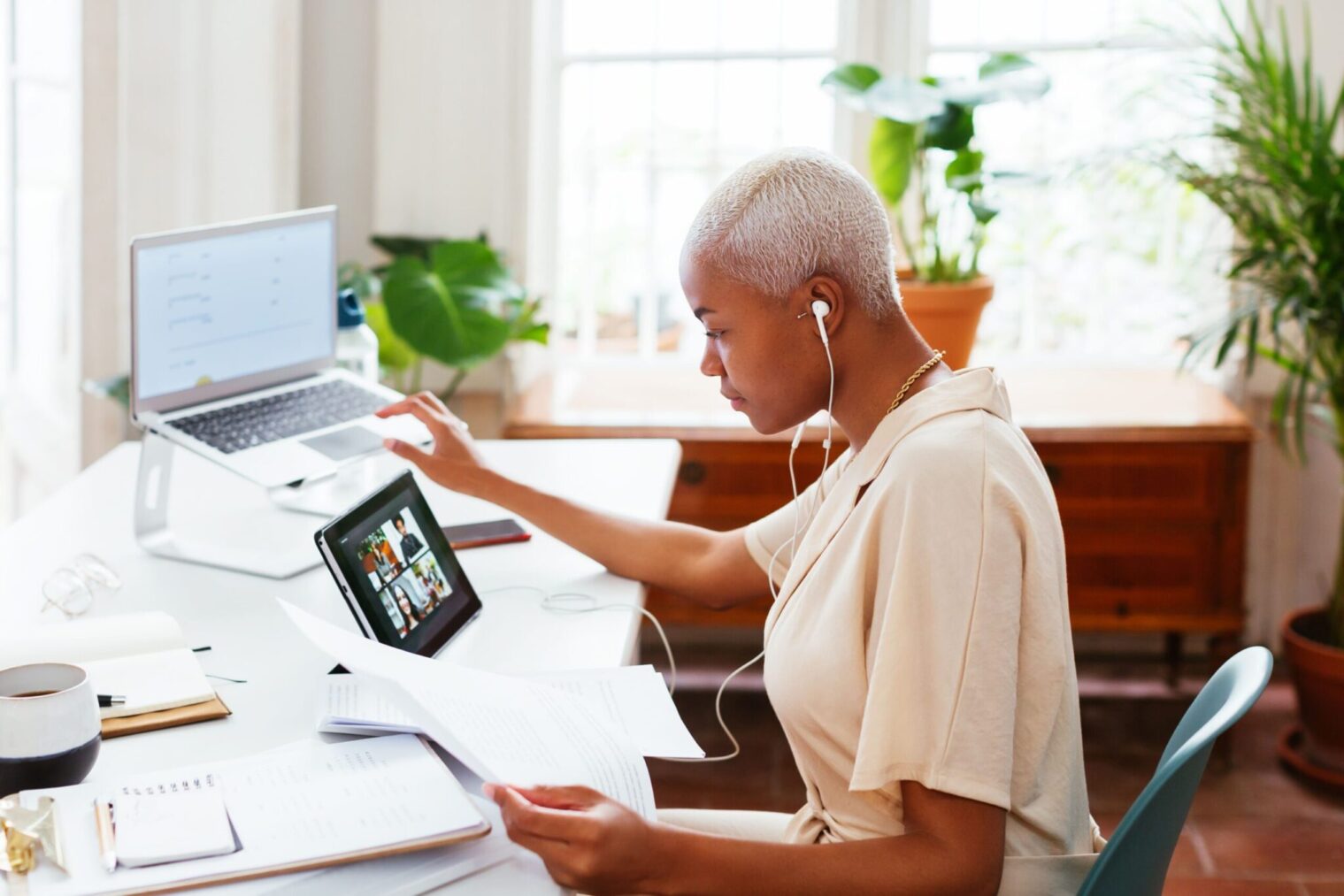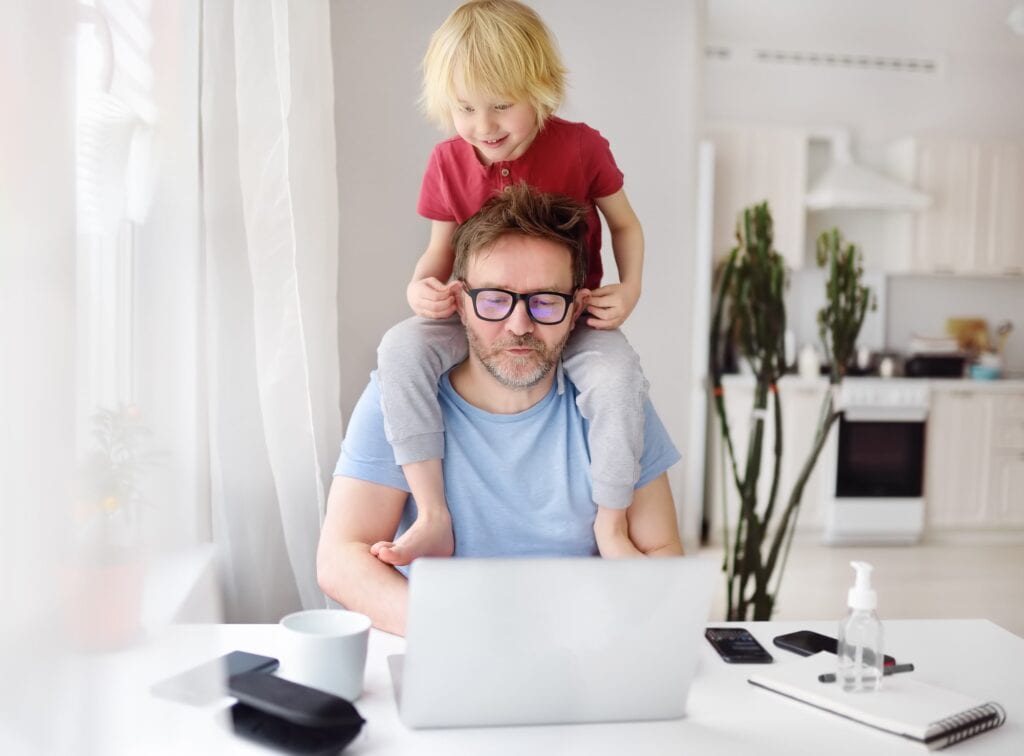
New Work: How mobile working is revolutionising our everyday life
“What was work like again before the pandemic?”, we asked ourselves in the team the other day. The ordinary office life, when we used to sit at our desks together instead of sending Slack messages back and forth and taking part in online meetings, feels strangely distant today.
According to a survey by the digital association, Bitkom, almost every second person currently works from their home office to at least some extent. Before the pandemic hit, working from home was the exception to the rule – only 3% of employees worked exclusively from home and 15% on some days of the week.
While many of us celebrate the home office, others are increasingly unhappy with this way of working. They either cannot concentrate well within their own four walls or miss the sense of belonging and interaction beyond virtual meetings and hangouts.
Now that this crisis has been with us for nearly a year, we would like to take stock of the situation through this article: How has our work life changed and what impact has this had on the workplace? What do employees long for when working from home and how can companies manage to understand and satisfy needs despite the distance?

Hand on heart – what is really the problem in the home office?
“The Corona pandemic acts as a trigger for sweeping and lasting changes in the professional world. After the forced migration to the home office for most people with the lockdown in spring 2020, employees have predominantly had positive experiences in these past few months,” says Bitkom President Achim Berg.
But we need to make sure the voices of those who disapprove are heard too. In fact, various surveys and studies show that working from home on a permanent basis does not leave our well-being unscathed:
- A third of Germans feel tense, irritable or anxious as a result of working from home. (LinkedIn)
- 80% of respondents work overtime in their home office. (LinkedIn)
- 39% of respondents aged 35-44 say they are particularly stressed due to the double burden of work and childcare. (LinkedIn)
- 71% of employees suffered from burnout symptoms in 2020. (Asana)
- A third of the 10% who are unhappy with the home office identify distraction factors as the main reason for their discontent. (IUBH)
What was long a utopian dream for many has become our reality sooner than we would have expected. And suddenly we are not so sure any more whether we wouldn’t actually prefer going back to the office.
Not so simple after all: overcoming the challenges of the new way of working
And this not only applies to employees. Most companies are forced to reinvent themselves quickly. Providing digital structures is one thing – but ensuring that these structures work is a whole other matter.
No wonder a survey by the American company, Asana, found that employees spend 60% of their day organising tasks, while only 26% of their time is spent on the actual skilled work (for which they were hired).
Many employees lack clarity about the distribution of roles, responsibilities and objectives – which naturally leads to an increase in the number of meetings. As a result, 13% of working time is spent doing double work, according to Asana.

Suddenly everything goes digital: How is the pandemic changing our workplace?
Especially for the “Trust is good – Control is better” generation, the new situation is turning things upside down and forcing them to open up to a new and mobile way of working. Truth be told, many bosses were astonished to see that their employees were even more productive than before during the last few months.
According to a study by the Bertelsmann Foundation, one third of the experts surveyed suspect that everyday office life as we know it will disappear. One third, however, predict that we will continue to go to a physical office when the crisis ends.
There will most likely be no one-size-fits-all solution in a post-crisis future, but rather a mix of virtual and physical office culture. Most importantly, more employees will have the opportunity to decide for themselves about the ideal work set-up – without anyone questioning their performance or productivity.

According to Bertelsmann, there is also a second emerging trend. Namely, that the pandemic will have a long-term effect on corporate sustainability. Experts believe that in the future there will be fewer business trips – and thus fewer flights – less commuting from A to B, employees will have more room for deceleration and the mutual needs of employees and employers can be better addressed.
Why virtual meetings cannot replace physical proximity
Precisely, needs – that’s what this article is about, after all. Younger people in particular struggle with isolation, as 53% of young professionals miss the daily interaction with colleagues. 43% miss the perks of office life, such as after-work drinks and small events.
In these times, many companies are putting effort into organising virtual events and meetings to compensate for the lack of physical proximity. But let’s face it, a friendly hug or a pat on the back of a colleague on a grim Monday morning is hard to reproduce digitally.
This is probably why 60% of all participants surveyed miss the social interaction – EVEN THOUGH the team spirit and communication within the team has stayed the same for the majority.
How companies can nurture connectedness in times of crisis
For the record: Physical proximity releases oxytocin and keeps both body and mind happy. This means that the employees are more productive and healthier.
Because physical proximity – especially for those living alone – is very difficult to achieve, companies have to get creative in order to satisfy the employees’ need for proximity. At Humanoo, we have come up with a few ideas:
- Meeting new people on a virtual coffee date – with some cake, of course.
How about having a virtual coffee with a randomly chosen colleague every week, during working hours, that is. You could enjoy a cup of coffee or tea, some cake and write down questions you would like to ask beforehand.
It’s great! You can get to know your colleagues (all of them, even the ones you tend to avoid) from a new aspect and bond on a whole other level.
In order not to pass this task on to the poor office manager again, there is, for example, Donut. Companies can easily incorporate this program and let the magic happen: Employees are matched with each other weekly and get to know one another again during an hour.
- “Welcome to my Crib” – just like on MTV.
Let’s be honest, we’ve all wanted to be a fly on the wall to see how our colleagues live. This format can finally help this dream come true – of course, only for those who are up for it.
The established group can draw lots at random to see who can give a virtual tour of their home, home office, garden or patio from time to time.
- “Are those barking noises? – cuddling your pet in the meeting.
Those who would rather present their pet than their whole flat will like this concept. The idea here is to grab your pet and introduce them virtually to your colleagues.
Dogs, cats, snakes or budgies – all hairy (and non-hairy) friends are welcome. Cute stories are guaranteed to strengthen the team spirit and warm our hearts.
PS: Did you know that petting an animal releases happiness hormones? One more reason for the pet-meeting!
- Join us and count your steps to brighten up your home office!
Thousands of employees are walking to beat the home office blues in our Humanoo Step Challenge in March.
The winners with the most steps will receive prizes such as high-quality designer furniture, delicious snack boxes, beautiful plants or the popular 6-minute diary. This is how you can transform your home office into paradise.
Information on participation, prizes and more can be found on our website.
And how will you get your dose of team spirit in the future?
We hope that this article has motivated you to come closer to your colleagues and to open up a little more. So that we can get even closer, especially in these times of isolation, and to make us feel like we are there for each other despite the distance – even if only virtually.
Keep your chin up when your heart gets heavy in these times. You’re not alone: many people miss working and sharing time together in the office, though some may not – which is also totally fine.
Because, most importantly, no matter how you feel about this new work situation, it’s perfectly valid and should not be judged. It is worth being mindful of your feelings.
There is no “one right reaction” to these new circumstances – there is only “your own way”. Whatever that may be, we would like to support you as best as we can so that you stay healthy physically and mentally.
We look forward to many virtual approaches, training sessions and steps together with you!
Your Humanoo team